It Is a Mark of to Know What Kind of Art
What to look for on the back of a painting — an adept guide
From its auction and exhibition history and provenance to notes from the artist on which way is 'Up', the details plant on the 'verso' tin significantly enhance a painting'south value
i. Who, what, when... and where
First and foremost, you'll want to know who painted your picture. Artists started signing their works around the 15th century, and while their signatures are most commonly on the front, in more recent times they accept been practical to the opposite.
Christie's specialists can check signatures by looking them up in the artist's catalogue raisonné and, sometimes, fifty-fifty narrow downwards the date a work was painted based on the evolution of a signature over time.
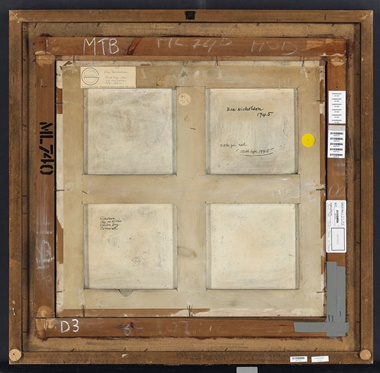
Nicholson'south address in Cornwall has been added bottom left of the back of the movie
The artist volition ordinarily also have provided a title or appointment. And sometimes more too.
'Every bit well as signing, naming and dating his works on the reverse, the British creative person Ben Nicholson (1894-1982) often included his address,' says Christie's Modern British and Irish Fine art specialist Alice Murray. 'Information technology's a lovely addition that helps yous build the story behind the artwork.'
2. Materials tin narrow down a painting's origins
Artists began switching from working on wooden panels to canvas in the 15th and 16th centuries because information technology enabled larger paintings. Painting on copper sheets as well became fashionable in the 17th century.
Stamps and labels from the suppliers of these materials can contain the names and addresses of their businesses. Reference lists — such as Alexander Katlan's American Artists' Materials Suppliers Directory — can be used to track them down, and in turn, narrow downward when and where a piece of work was made.
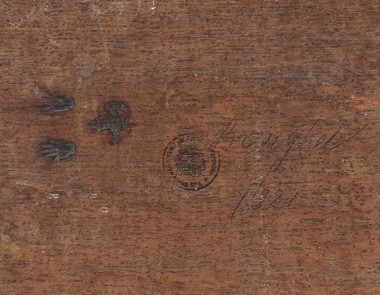
The reverse of a 16th-century oil painting panel showing the brand of the metropolis of Antwerp — a pair of hands above a castle. The mark dates from 1617, when new regulations drawn up by the Antwerp Joiners' Society stated 'every joiner is from now on obliged to punch his mark on frames and panels fabricated by him, on pain of a fine of three guilders'
Comparing the date the materials were purchased with the date the artist signed the finished work can fifty-fifty requite y'all an idea of how long it took to complete.
The types of materials used to create a work's board, cradle or stretcher, forth with how it was synthetic, too vary over time and between places.
Soft forest, such as poplar, was used in Italy, while hard wood, for case oak, was used in Britain and the Netherlands. Some other clue can be obtained from how the sheet is stock-still to the stretcher — staples replaced nails subsequently the 1940s.
3. Labels indicate provenance and exhibition history
When a gallery or museum displays a work of art it ofttimes attaches a characterization to its back that indicates the artist's proper name, the flick's title, and usually a date, inventory number and address.
'With the appearance of the internet it has become much easier to research these labels,' explains Impressionist and Modern Fine art specialist Veronica Scarpati. 'For example, the Museum of Modernistic Art has digitised all of its exhibition catalogues, press releases and lender lists as far back every bit 1929.'
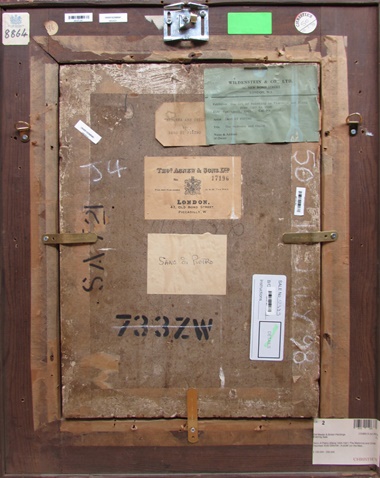
The back of Pietro's painting with stencils, stickers and labels, including those of London dealer Thomas Agnew & Sons and New York gallery Wildenstein & Co.
Other cardinal players to await out for include institutions such as the Purple University or the Metropolitan Museum of Art, and dealers similar Richard Greenish, The Fine Art Guild or Wildenstein & Co., as seen, meridian right, on the back of the picture shown above.
Other labels that record a painting's journeying can come from conservators, customs and edge controls, or even defunct bureaucratic mechanisms such as the Nazis' Chamber of Culture, which stamped its double-headed eagle logo on to the back of the fine art it looted.
iv. Inscriptions will also accept a story to tell
Private collectors throughout history have added their own names to the dorsum of a work. Male monarch Charles I of England (1600-1649), for example, branded his initials 'CR' topped with a crown onto the reverse of works in his majestic collection.
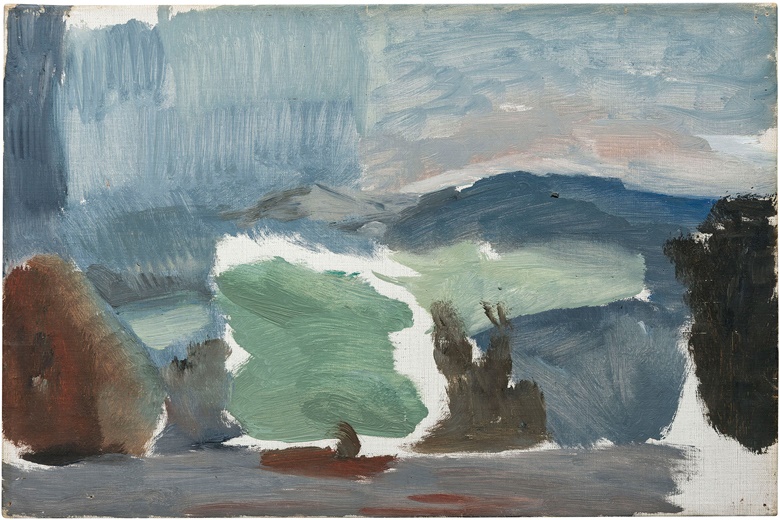
Ivon Hitchens (1893-1979), Hills and Darkening Sky: Pelting over the Downs. Oil on canvas. 12½ x 18½ in (31.7 10 47 cm). Sold for £32,500 on 23 January 2020 at Christie'south in London. Artwork: © The Estate of Ivon Hitchens. All rights reserved, DACS 2020
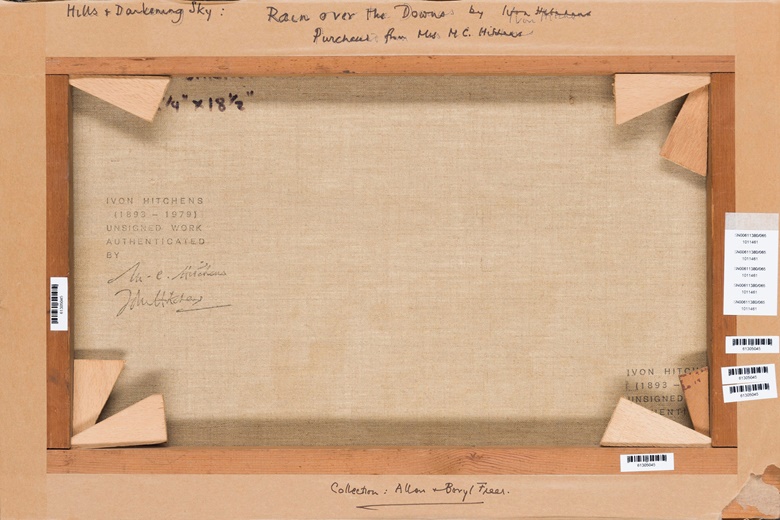
Allen Freer's handwritten provenance is on the bottom of the stretcher for Hills and Darkening Heaven
'On the back of this landscape [above] by Ivon Hitchens (1893-1979) yous have the stamp of his wife, Mollie, likewise as a after, handwritten notation placing information technology in the collection of Allen and Beryl Freer,' explains Alice Murray.
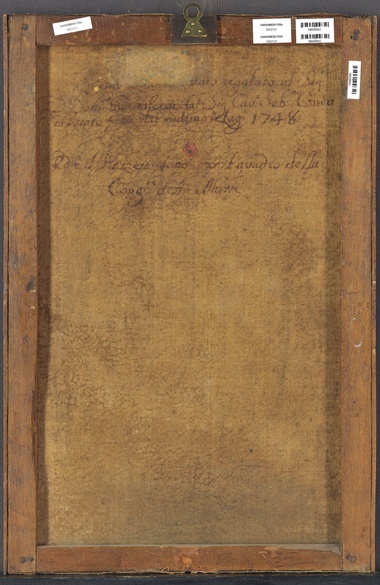
The back of Conca'south painting features a handwritten inscription indicating that is was souvenir to one D. Domenico Guastaferro
In 2019, Christie's sold a painting [above] past Sebastiano Conca (1680-1764), which contains an onetime hand-written note that describes its title, appointment and the fact it was a bozzetto — or sketch — for painting, too as providing some provenance — that information technology was gifted to ane D. Domenico Guastaferro in July 1748.
If you determine to add a back up to the back of your painting, information technology might be an idea to use Perspex so that the labels remain visible, or enquire a paper conservator to carefully transfer them onto the new board.
v. Inventory numbers reveal a work'south auction history
Since the early 19th century Christie's has marked the back of pictures with an inventory number. Initially these numbers were stencilled in black ink, while other auction houses used chalk. (Today, rather than stencilling numbers on the back of pictures, it is more mutual for a sticker with a barcode to be applied.)
'These numbers correspond to records that tell us when and where something was sold, and sometimes who sold it and what price was paid,' explains Christie's librarian and archivist Lynda Macleod. 'The Christie's athenaeum in London has details of most of the sales held during the sale house's 254 years in business.'
'When cataloguing paintings these stencils allow united states non merely to slice together provenance, but also to see if the work has been attributed to different artists in the by,' adds Olivia Ghosh, a specialist in Christie'south Former Masters department.
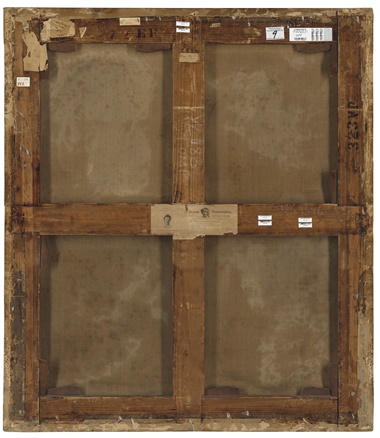
The reverse of Rembrandt'south Homo with a Sword showing its sale stencils, and in the centre, an 1898 Amsterdam exhibition label
In 2013, Christie's sold a portrait by Rembrandt (1606-1669)and his studio which had '272ER' stencilled on the back. 'That pointed us to a 1928 auction at Christie's of a drove belonging to Sir George Lindsay Holford,' Ghosh explains.
'From there nosotros traced the painting'south provenance back to his male parent, Robert Stayner Holford, who was the founder of the Burlington Fine Arts Social club and owned three other Rembrandts, all now in museums. Knowing these details can add groovy value to a painting.'
six. If the painting has been lined, repair work may have been carried out
If the rear of the sheet has traces of glue effectually the edges, or feels thick and new, the painting may take been lined. This refers to the procedure of attaching an additional layer of canvas to the original surface in club to repair holes and tears and stabilise the painting.
'Lining a sail was, and still is, a mutual practice for Sometime Master paintings,' says Ghosh. 'In the by it was often done with a heavy hand, but now it tin can be completed without damaging the paint's surface.'
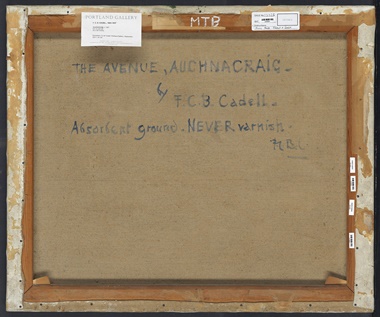
F.C.B. Cadell left clear instructions on the back of his works almost how to care for them in the future
'The Scottish colourist F.C.B. Cadell (1883-1937) left clear instructions regarding how to maintain the condition of his works on their opposite,' says Alice Murray. 'On the back of The Avenue, Auchnacraig [to a higher place] are the words "Absorbent ground/NEVER varnish", considering Cadell felt the chalky quality of his pigment surface was of utmost importance.'
vii. Warped stretchers can be a giveaway that it has been hung in boiling conditions
Major cracks in the work might point that information technology has been hung in a hot, dry place, such as to a higher place a fireplace, while warped stretchers could advise it lived in a bathroom. 'Neither are advisable,' states Ghosh.
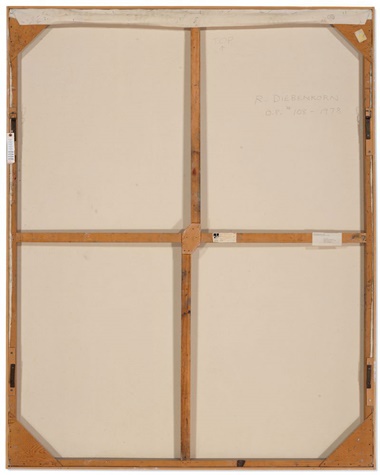
The opposite of Diebenkorn'southward painting helpfully explains which way upward it should exist hung
While not venturing so far as to specify where they should be hung, some artists, such as Richard Diebenkorn (1922-1993), helpfully go out notes to signal their correct orientation. On the back of the work above Diebenkorn has written in pencil 'TOP', with an pointer pointing up.
Sign up today
The Online Mag delivers the best features, videos, and sale
news to your inbox every weekSubscribe
8. On rare occasions, the dorsum of a painting can even reveal another work of art
Every at present and over again the back of a painting can reveal something that rivals the importance of the piece of work of art on the front end, such as a handwritten annotation by the artist —or fifty-fifty a second picture.
'Materials have historically been expensive, so impoverished artists were known to endeavor out different compositions on the same supports,' Ghosh explains.
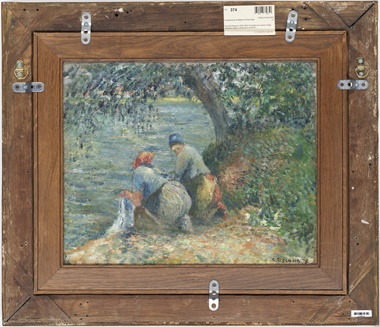
Set into the back of Pissarro's 1878 scene of farmyard birds is some other work entirely, depicting two women washing laundry
Veronica Scarpati proffers an example. 'In Feb this yr Christie's sold a work by Camille Pissarro (1830-1903) which had a second, signed Pissarro on the opposite,' she explains.
'Christie's art handlers mounted it in a custom-made support and then that both sides could be seen during the auction preview. If it had been hanging on a wall, no one would have had an clue of what the back was hiding.'
Source: https://www.christies.com/features/8-things-you-can-learn-from-the-back-of-a-painting-10293-1.aspx